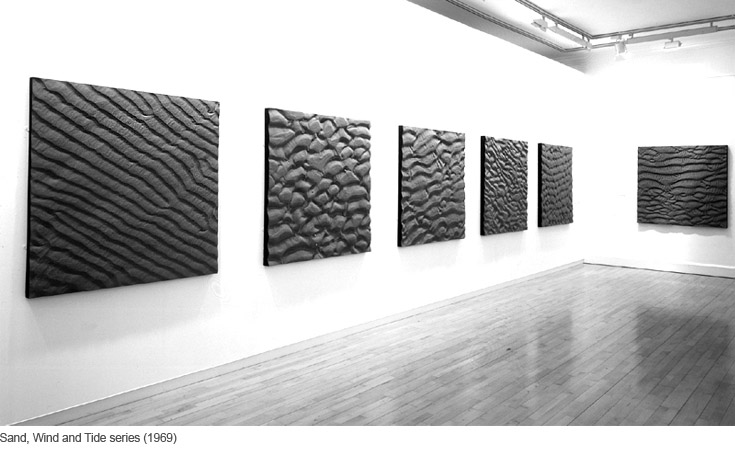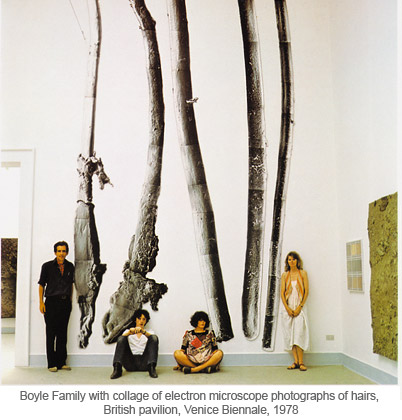Boyle Family: an introduction

Boyle Family is a group of collaborative artists based in London. Mark Boyle and Joan Hills met in Harrogate, Yorkshire in 1957. Joan had studied art and architecture and was bringing up her first son Cameron whilst running her own business. Mark was in the army, writing poetry. After a period of working separately on visual art pieces, they incrementally moved into a natural collaboration - agreeing that art should not exclude anything as a potential subject.
Wherever Mark and Joan lived became their studio, so it seemed natural and necessary that friends and family be co-opted to help whenever there was a big show going off or an event to put on. From very early on, Mark and Joan’s children, Sebastian and Georgia, went around the studio, doing bits here and there, gradually getting more deeply involved: going on working trips, expeditions, helping to finalise and hang exhibitions. This co-creational approach also was applied to the evolution of the work itself and led to innovative and collaborative partnerships with many artists, performers, musicians, filmmakers and dancers, notably Jimi Hendrix and the psychedelic jazz-rock pioneers Soft Machine.
Originally the work went under Mark Boyle's name, largely because Mark and Joan were more concerned with making their work than attempting to fight the stereotype that artists were solo and usually male. Labels never mattered to them - it was the work that was important, not the marketing, image or personal recognition. Taking the view that if the art world wanted to believe in obsessed, lone male artists starving in their studios, they could present their work in a way that would fit. However, as their work became widely known, and at the same time the artistic stereotype began to broaden, they began to exhibit as Mark Boyle and Joan Hills. As adults, Sebastian and Georgia both opted to remain part of the team and since 1985 the four of them have exhibited as Boyle Family. Following the death of Mark Boyle in May 2005, Boyle Family continues to work and exhibit internationally, and to progress the execution of their best known work, the huge global World Series.
Boyle Family aims to make art that does not exclude anything as a potential subject. Over the years, subjects have included: earth, air, fire and water; animals, vegetables, minerals; insects, reptiles, water creatures; human beings and societies; physical elements and fluids from the human body. The media used have included performances and events; films and projections; sound recordings; photography; electron-microphotography; drawing; assemblage; painting; sculpture and installation.
Boyle Family is best known for the earth studies: three dimensional casts of the surface of the earth which record and document random sites with great accuracy. These works combine real material from the site (stones, dust, twigs etc) with paint and resins, preserving the form of the ground to make unique one-off pieces that suggest and offer new interpretations of the environment, combining a powerful conceptual framework with a strong and haunting physical and visual presence.
These ideas are strongly enshrined in the major Boyle Family work, World Series, initiated in 1968 as part of the exhibition Journey to the Surface of the Earth at the Institute of Contemporary Arts London. The World Series has been developed over the past forty years alongside a number of parallel and related series and projects including: the London Series; Tidal Series; Thaw Series; Japan Series. Each of these groups of work has involved various random selection techniques to isolate a rectangle of the Earth's surface. In the case of the World Series 1000 sites were chosen at random by visitors to the artists’ studio and the ICA exhibition. Participants were blindfolded and either threw a dart or fired an air rifle at an unseen wall-sized map of the world, which now forms part of the work itself.
This random selection serves several purposes: nothing is excluded as a potential subject; the particular is chosen to serve as a representative of the whole; the subjective role of the artists and creators is re-designated to that of ‘presenters’. Boyle Family seeks to present a version of reality as objectively and truthfully as possible, calling this process ‘motiveless appraisal’.
Once the random selection of subject has been made, the artists recreate the site in a fixed and permanent form as a painted fibreglass relief. They recognise that each work is in some respect necessarily flawed because the selections can never be truly random and that it is impossible to eliminate themselves and their own subjective influences. They attempt to present a slice of reality as they found it at the moment of selection, but no matter how good the re-creation, it is still a re-creation and only an approximation of reality. Boyle Family know that it is impossible to tell the truth, the whole truth and nothing but the truth, but in their work they try to isolate and reduce randomly chosen elements to as truthful an approximation as is within their power.
 Their search is to find out if it is possible for an individual to free him/herself from conditioning and prejudice. To see if it is possible to look at the world, or a small part of it, without being reminded consciously or unconsciously of myths and legends, art of the past or present, art and myths of other cultures. ‘We also want to be able to look at anything without discovering in it our mothers' womb, our lovers' thighs, the possibility of handsome profit or even the makings of an effective work of art. We don't want to find in it memories of places where we suffered joy and anguish or tenderness or laughter. We want to see without motive and without reminiscence this cliff, this street, this field, this rock, this earth.’(1)
Their search is to find out if it is possible for an individual to free him/herself from conditioning and prejudice. To see if it is possible to look at the world, or a small part of it, without being reminded consciously or unconsciously of myths and legends, art of the past or present, art and myths of other cultures. ‘We also want to be able to look at anything without discovering in it our mothers' womb, our lovers' thighs, the possibility of handsome profit or even the makings of an effective work of art. We don't want to find in it memories of places where we suffered joy and anguish or tenderness or laughter. We want to see without motive and without reminiscence this cliff, this street, this field, this rock, this earth.’(1)
Boyle Family has exhibited in galleries and museums world-wide, including representing Britain at the Venice Biennale in 1978 and the Sao Paulo Biennale in 1987. Their exhibition ‘Beyond Image’ at London's Hayward Gallery in 1986 attracted 176,000 visitors. Their work is represented in many private and public collections with major works in forty museum collections worldwide, including Tate Britain; Stuttgart Staatsgalerie; Los Angeles County Museum; Kunstmuseum Luzern; Tokyo Metropolitan Museum; Museum Moderna Kunst Vienna.
1) Boyle Family Beyond Image Catalogue, 1986